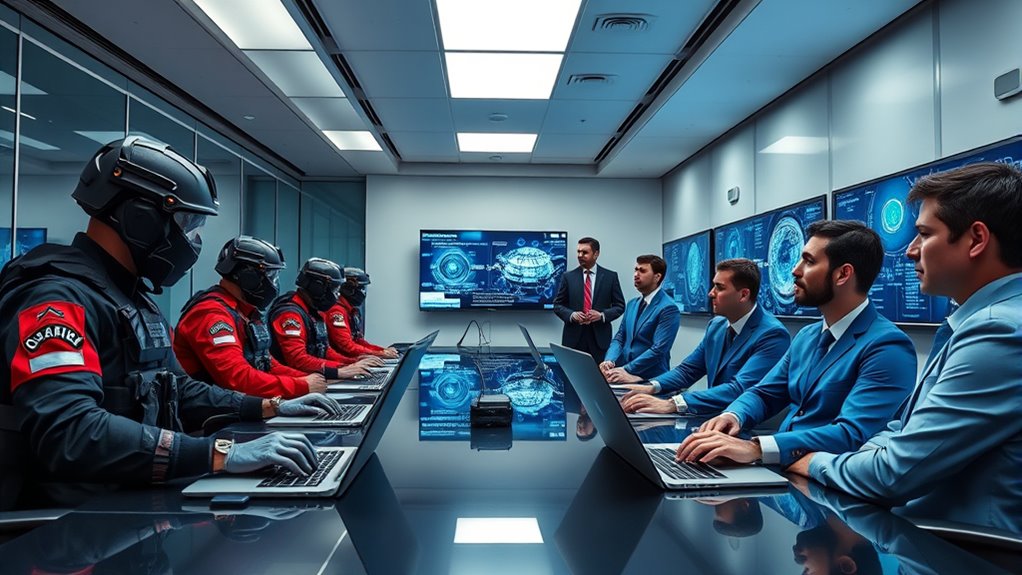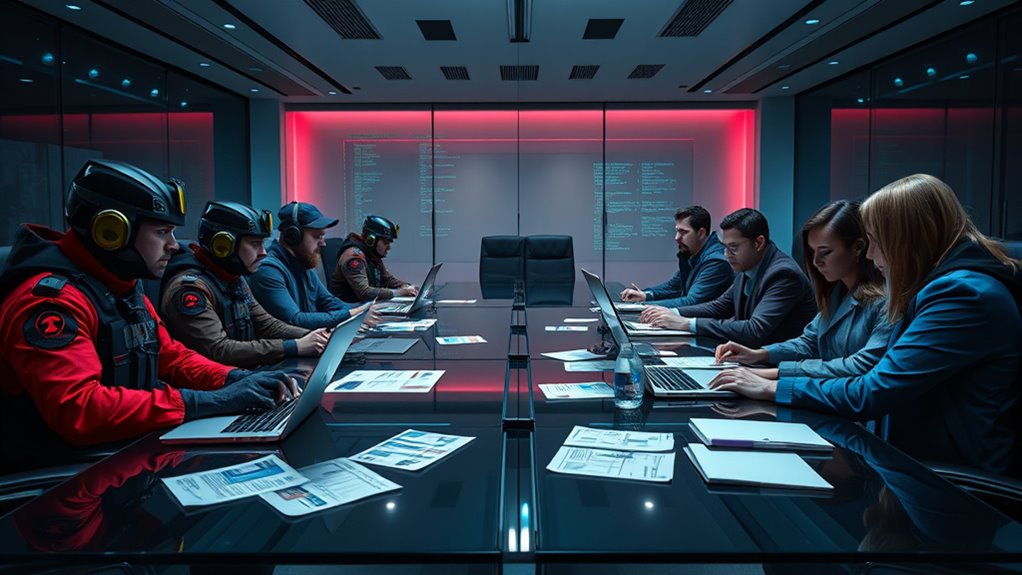Before launching new systems, it’s essential to conduct stress-testing with red and blue teams. Red Teams simulate real-world attacks, finding vulnerabilities, while Blue Teams focus on defense and response. Their collaboration helps you identify security gaps, improve threat detection, and strengthen defenses before an actual breach occurs. By planning effective exercises, analyzing outcomes, and continuously updating strategies, you can guarantee your security measures are robust. Keep going to discover how you can build a resilient security approach.
Key Takeaways
- Conduct realistic attack simulations with Red Teams to identify vulnerabilities before deployment.
- Use Blue Teams to develop layered defenses and improve response protocols based on stress-test findings.
- Coordinate Red and Blue Teams to simulate threat scenarios reflecting current attack vectors and insider threats.
- Incorporate continuous feedback and lessons learned to refine security measures prior to launch.
- Validate security effectiveness under pressure to reduce post-launch breach risks and build confidence in defenses.
Understanding the Roles of Red and Blue Teams

Understanding the roles of Red and Blue Teams is essential for grasping how organizations strengthen their cybersecurity defenses. Red Teams simulate real-world attackers, using threat modeling to identify vulnerabilities and test security measures. They think like hackers, probing systems for weaknesses. Conversely, Blue Teams focus on defending and protecting assets, coordinating efforts to detect, respond to, and mitigate threats. Effective team coordination between these groups ensures an extensive security approach, with Red Teams uncovering gaps and Blue Teams closing them. This dynamic interaction helps organizations understand their security posture and improve defenses continually. By clearly defining each team’s responsibilities, companies can create a proactive environment where threats are identified early, and defenses are strengthened before real attacks occur. Additionally, understanding the safety features of security tools can enhance defensive strategies and reduce risks.
The Benefits of Simulated Cyber Attacks

Simulated cyber attacks help you spot security gaps before real hackers do. They provide valuable insights to strengthen your defenses and prevent costly breaches. By regularly testing your systems, you stay a step ahead of evolving threats. Incorporating security testing into your routine can reveal vulnerabilities that may otherwise go unnoticed.
Identifying Security Gaps
By conducting simulated cyber attacks, organizations can uncover vulnerabilities that might otherwise go unnoticed during routine security assessments. Penetration testing allows you to actively probe your systems, revealing weak points before attackers can exploit them. Threat modeling helps identify potential attack vectors and prioritize risks, guiding targeted defenses. These methods expose security gaps in your infrastructure, policies, and processes, giving you a clear picture of where weaknesses lie. Simulations also reveal how different vulnerabilities could be exploited in combination, highlighting areas needing immediate attention. Additionally, integrating AI in cybersecurity can enhance threat detection and response capabilities during these stress tests. By thoroughly testing your defenses in a controlled environment, you gain valuable insights into your security posture and can address gaps proactively. This approach guarantees you’re better prepared to defend against real-world threats before they materialize.
Enhancing Defensive Strategies
Implementing simulated cyber attacks strengthens your defensive strategies by providing real-world testing of your security measures. Threat simulation allows you to identify vulnerabilities before malicious actors do, giving you a clearer picture of your weaknesses. Penetration testing, a core component of threat simulation, actively probes your systems to uncover exploitable gaps. These exercises help you understand how well your defenses hold up under attack and reveal areas needing improvement. By regularly conducting simulated attacks, you can refine your security protocols, improve response times, and build resilience. Ultimately, this proactive approach enhances your overall cybersecurity posture, ensuring your organization is better prepared to defend against actual threats. Continuous testing keeps your defenses sharp and adaptive in an ever-changing threat landscape. Incorporating cybersecurity best practices into your simulations further strengthens your defenses and prepares your team for emerging challenges.
Planning Effective Red Team Exercises

How can you guarantee your red team exercises are truly effective? Start by clearly defining your objectives and scope, aligning them with your organization’s threat intelligence insights. Focus on realistic scenarios that include insider threats, which are often overlooked but highly damaging. Incorporate intelligence on current attack vectors and vulnerabilities to create targeted and relevant challenges. Ascertain your team understands the rules of engagement and stays within legal boundaries. Planning should also include logistical details like timelines, resources, and communication protocols. By carefully designing scenarios rooted in actual threats, you enable your red team to simulate real-world attacks, revealing weaknesses and testing your defenses thoroughly before an actual breach occurs. Additionally, understanding unique security challenges can help tailor scenarios that better reflect your environment’s specific risks.
Developing Defensive Strategies With Blue Teams

Developing effective defensive strategies with blue teams requires a proactive approach that anticipates potential threats and minimizes vulnerabilities. To do this, you should implement network segmentation, dividing your network into isolated segments to contain breaches and limit lateral movement. This strategy helps contain the impact of an attack and simplifies monitoring. Additionally, focus on insider threat mitigation by establishing strict access controls, monitoring user activity, and enforcing the principle of least privilege. Regular training and awareness programs are essential to help your team identify suspicious behavior early. Combining these measures, your blue team can create a layered defense that not only detects intrusions quickly but also reduces risks from internal and external threats. Being aware of potential cheating tactics can also inform your threat models and improve your defensive strategies. Proactive planning guarantees your defenses stay resilient against evolving cyber risks.
Identifying Vulnerabilities Through Red Team Testing

Red team testing builds on your blue team’s layered defenses by actively probing for weaknesses before real attackers can exploit them. Through targeted penetration testing, you identify vulnerabilities in systems, applications, and network configurations. This process reveals security gaps that might go unnoticed during routine checks. Additionally, threat hunting plays a vital role by proactively searching for signs of compromise or overlooked vulnerabilities within your environment. By simulating sophisticated attack techniques, red teams expose weaknesses in your defenses, helping you understand potential entry points and attack vectors. This insight allows you to prioritize remediation efforts effectively. Ultimately, red team testing provides a thorough view of your security posture, equipping your team with the knowledge needed to strengthen defenses before an actual breach occurs. Continuous support throughout the project lifecycle ensures ongoing resilience and improvement.
Enhancing Response Capabilities During Simulations

To effectively respond to simulated cyberattacks, your team must be prepared to act swiftly and decisively. Incorporate regular phishing simulations to test your staff’s ability to recognize and handle malicious emails, strengthening your defense against social engineering. During these exercises, focus on rapid response protocols, ensuring everyone knows their roles. Address insider threats by monitoring suspicious activity and practicing immediate containment measures. Use real-time feedback to identify gaps in your response, adjusting procedures to improve efficiency. Encourage clear communication and coordination among team members to minimize chaos during an attack. The goal is to simulate high-pressure scenarios, so your team becomes confident in their ability to neutralize threats quickly, reducing potential damage and reinforcing a proactive security culture. Additionally, understanding the types of cybersecurity tools available can help tailor your response strategies more effectively.
Integrating Findings Into Security Policies

You need to update your security policies based on the insights gained from red and blue team exercises. Implement policy adjustment strategies that address identified gaps and vulnerabilities promptly. Regularly review and refine these policies to make certain of continuous improvement and resilience against evolving threats. Incorporating ongoing training ensures your team stays prepared for emerging security challenges.
Policy Adjustment Strategies
Integrating findings from red and blue team exercises into security policies requires a strategic and systematic approach. Focus on identifying vulnerabilities related to insider threats, and modify policies to mitigate these risks effectively. Review existing compliance standards to make sure your policies align with legal and industry requirements. If gaps are found, update access controls, monitoring procedures, and incident response plans accordingly. Clear communication of policy changes is essential so that all stakeholders understand new protocols. Regularly document these adjustments to track progress and facilitate audits. Remember, the goal is to create adaptive policies that respond swiftly to emerging threats while maintaining compliance. Incorporating sound recording techniques can also enhance your security measures by providing detailed audit trails of audio evidence in certain investigations. This proactive approach strengthens your security posture and prepares your organization for future challenges.
Continuous Improvement Measures
Building on the foundation of policy adjustments from red and blue team exercises, establishing continuous improvement measures guarantees security policies stay effective over time. Regularly review findings from simulations and real-world incidents to refine your security awareness programs. Incorporate insights gained from threat modeling to identify emerging risks and adapt policies accordingly. This proactive approach ensures your team stays prepared and vigilant. Continuously updating policies based on practical feedback helps close gaps and aligns your security posture with evolving threats. Engaging stakeholders in ongoing assessments fosters a culture of vigilance and learning. By embedding these measures into your security framework, you maintain resilience and ensure your policies evolve alongside the threat landscape. This cycle of improvement is key to long-term security success.
Common Challenges and How to Overcome Them

What are the most common hurdles faced by red and blue teams during their operations, and how can they be effectively tackled? One challenge is staying ahead of evolving tactics, especially when conducting phishing exercises, which require constant updates to mimic real-world scams. Insider threats also pose significant risks, as internal actors may bypass security measures or intentionally sabotage efforts. To overcome these issues, teams should foster open communication, regularly review and update their procedures, and incorporate threat intelligence. Simulating realistic phishing scenarios helps identify vulnerabilities, while training employees on recognizing insider threats strengthens overall security. Addressing these hurdles proactively ensures your testing remains effective, reduces blind spots, and enhances your organization’s resilience against both external and internal threats.
Best Practices for Continuous Security Improvement

To guarantee your security posture keeps pace with evolving threats, adopting a mindset of continuous improvement is essential. Regular threat modeling helps you identify vulnerabilities before attackers do, ensuring your defenses stay relevant. Incorporate threat hunting into your routine to proactively detect and respond to hidden threats lurking in your environment. Keep security practices dynamic by reviewing and updating policies based on new intelligence and past incidents. Foster collaboration between your red and blue teams to share insights and refine strategies constantly. Use lessons learned from simulated attacks to strengthen defenses and close gaps. By maintaining an iterative approach, you ensure your security measures evolve with the threat landscape, making your organization more resilient over time.
Measuring Success and Refining Your Approach

To improve your security efforts, you need clear metrics to evaluate progress and identify weaknesses. Analyzing testing outcomes helps you understand what works and what doesn’t. By continuously refining your strategies through iterative improvements, you guarantee your defenses stay strong and adaptive.
Metrics for Evaluation
Measuring success in red team and blue team exercises requires clear, quantifiable metrics that reflect both technical and strategic performance. Security metrics serve as objective benchmarks, helping you evaluate how effectively vulnerabilities are identified and mitigated. Evaluation criteria should encompass aspects like detection times, response accuracy, and attack success rates for red teams, alongside resilience, coverage, and improvement areas for blue teams. These metrics enable you to gauge progress, identify gaps, and refine strategies. By establishing specific, measurable goals, you can track performance over time and ensure your testing aligns with organizational priorities. Ultimately, using well-defined security metrics provides a solid foundation for continuous improvement and more effective stress-testing before launch.
Analyzing Testing Outcomes
Analyzing testing outcomes is essential for understanding how well your red and blue team exercises achieved their objectives. After a penetration testing or threat modeling session, review the results carefully. Identify which vulnerabilities were exploited and which defenses held strong. Look for patterns in attack methods and areas where your defenses need reinforcement. Quantify success by measuring the number of vulnerabilities discovered and the time taken to detect and respond. Use this data to refine your security posture. Remember, the goal isn’t just to find flaws but to understand how effective your current strategies are. Accurate analysis helps you determine whether your defenses are improving or if additional measures are necessary before launch. This step guarantees continuous improvement and readiness.
Iterative Improvement Strategies
Effective iteration begins with accurately evaluating your current security posture. Conduct regular penetration testing to identify vulnerabilities and understand how your defenses hold up under simulated attacks. Use threat modeling to anticipate potential attack vectors and prioritize remediation efforts. After each assessment, analyze the results to pinpoint weaknesses and determine what worked well. Refine your security strategies by integrating lessons learned into your next testing cycle. This continuous feedback loop allows you to adapt quickly, patch vulnerabilities, and strengthen defenses. Remember, iterative improvement isn’t a one-time effort; it’s an ongoing process that keeps your security posture resilient. By consistently measuring success through targeted testing and threat analysis, you can ensure your approach evolves alongside emerging threats.
Frequently Asked Questions
How Often Should Red and Blue Team Exercises Be Conducted?
You should conduct penetration testing and threat modeling exercises regularly to stay ahead of potential threats. Ideally, perform these exercises at least quarterly, but more frequent testing—such as monthly—can better identify vulnerabilities early. Consistent testing helps you refine security measures, improve response plans, and guarantee your defenses are robust. Regular assessments also keep your team prepared for evolving attack techniques, ultimately strengthening your overall security posture.
What Tools Are Most Effective for Red Team Simulations?
To conduct effective red team simulations, you should rely on tools that enhance penetration testing and threat modeling. Use automated scanning tools like Nessus or Burp Suite to identify vulnerabilities quickly. Incorporate threat modeling software such as Microsoft Threat Modeling Tool or STRIDE to anticipate attack vectors. These tools help you simulate real-world attacks, improve security posture, and prepare your team to respond effectively to different threats.
How Can Organizations Ensure Unbiased Red Team Assessments?
To guarantee unbiased assessments, you should focus on bias mitigation and assessment transparency. Encourage diverse teams to bring varied perspectives, reducing the risk of blind spots. Implement clear, standardized evaluation criteria and document all findings openly. Regularly review your processes to identify and address potential biases. By fostering an environment of transparency, you help guarantee your assessments are fair, objective, and provide an accurate picture of your organization’s security posture.
What Metrics Best Evaluate Blue Team Response Effectiveness?
You should focus on metrics like how quickly your team detects and responds to simulated breaches, which reflect your incident response effectiveness. Penetration testing results help measure the team’s ability to identify vulnerabilities, while response time and recovery speed show how well they contain threats. Tracking false positives and the quality of communication also provides insight into response accuracy and coordination, ensuring your blue team strengthens its defenses efficiently.
How Do Red and Blue Teams Collaborate Post-Exercise?
Did you know that 85% of organizations see improved security when teams collaborate effectively? After an exercise, you should focus on cross-team communication and post-exercise feedback. This helps identify gaps, share insights, and strengthen defenses. By actively engaging in debriefs and open discussions, you guarantee continuous improvement. Your collaboration after these exercises is essential for refining strategies and building a resilient security posture.
Conclusion
By embracing red and blue team exercises, you’re effectively sharpening your defenses before an attack occurs. Think of it as preparing your fortress against invaders—better to fortify the walls now than mend the damage later. Continuously test, learn, and adapt your strategies. Remember, an ounce of prevention is worth a pound of cure. Stay proactive, and your security will stand strong against any threat that comes your way.









